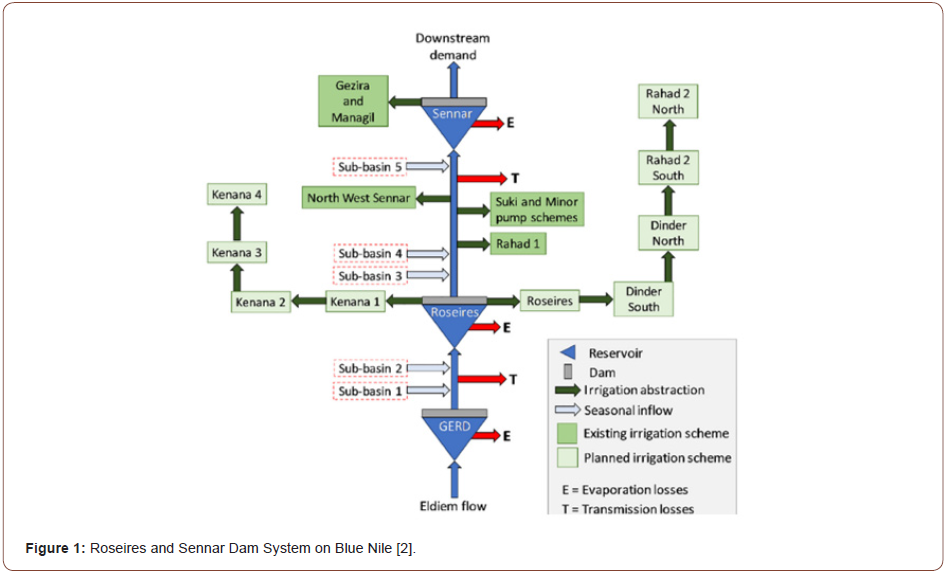Authored by Thoaiba Zain Elabdin Saad Omer*,
Abstract
Increasing the economic profit from reservoir operation in a case study on Blue Nile River in Sudan is the aim of this research short communication. An already developed model that optimizes the coordinated reservoir operation is used to obtain maximum profit from energy generation in a two-reservoir system, i.e., Roseires and Sennar Dam System through the reservoir operation coordinating. An economic crop pattern mix along with two energy generation scenarios in normal year condition are analyzed. Results show that with existing facilities and reservoir operation coordination, 89.5 M$ marginal profit can be obtained, by 280 MW power capacity of Roseires and planned future 50 MW power capacity at Sennar Dam. Model later optimizes the required power capacity and power flow to determine the maximum energy generation in this system. Model shows that in such conditions power capacity of Roseires and Sennar dam can be increased by 528 MW and 568 MW, respectively, to produce 4078 GWh per year energy with 375.3 M$ marginal profit. This modeling shows that by addition of each 1 MW to the power capacity of Roseires and Sennar Dam, respectively, 442,000 $/MW and 249,000 $/MW profit can be obtained at maximum, which is also showing the value of coordination in this system.
Keywords: Hydropower; Roseires dam; Sennar dam; Optimum coordinated reservoir operation
Abbreviations: MPC: Maximum Power Capacity; EPC: Existing Power Capacity
Introduction
Roseires and Sennar dams shown in Figure 1, play a very important role in water supply to the largest irrigation projects on Blue Nile river basin [1,2]. These dams also generate electricity with 280 MW and 50 MW power at Roseires and Sennar dams, respectively [1]. Existing rule curves of the Roseires and Sennar dams have created up to 67% shortage in supplying water to irrigation schemes demands [3]. On the other hand, new irrigation schemes with 1000,000 ha area are planned to be added to the existing irrigation schemes [2]. Climate change also is predicted to decrease the inflow up to 25% and increase the evapotranspiration by 19% [4]. These factors clearly show that future situation of the river basin will put the water resources and supply in more tension. Therefore, reservoir operation coordinating is suggested as an approach to overcome future tense conditions of water resources utilization [5]. In this short communication the results of applying this model for hydroelectricity development scenarios analysis is presented and discussed.
Discussion
In this short communication, results of a coordinated longterm reservoir operation model, which is developed and validated by observed reservoir operation data of 1999-2000, are presented (Figure 1).

In this model, two scenarios are analyzed for an economic crop pattern [2]:
1. Maximum Power Capacity (MPC), where model determines the maximum power capacity required, achievable energy and marginal profit that can be made in a normal year through coordinated reservoir operation.
2. Existing Power Capacity (EPC) [6], where model determines by reservoir operation coordinating within the existing reservoir condition optimum level of electricity generation and its marginal profit
Results of these scenarios’ analysis are shown in Tables 1 and 2 (Tables 1, 2).
Table 1: Energy generation and required power capacity.

Table 2: Economic aspects of power generation through coordinated reservoir operation in MPC scenario.

Results of MPC and EPC scenarios after analysis by the multiperiod optimization model that analyzes the Roseires and Sennar coordinated reservoir operation are presented. These results show that coordinated reservoir operation in existing situation with the suggested crop pattern can manage the energy production so that for addition of every 1 MW to the capacity of the power in the reservoirs produces 442,000 $/MW and 249,000 $/MW for Roseires and Sennar reservoirs, respectively. The power capacity if increased to 808 MW and 613 MW it can produce up to 4078 GWh per year. However, in the current situation 973 GWh per year can be produced by coordinated reservoir operation that can result to 89.5 M$ per year, where 78.7 M$ for 10.8 M$ for Roseires and Sennar hydropower, respectively. Existing power capacity of Roseires and Sennar Dams dates back to 1966 and 1925, respectively, when energy demand were by far smaller and later also the government did not plan for enhancement of the power capacity in terms of power or turbine flow. However, this research shows if engineering costs of this enhancement in energy generation can be well below the added value per each 1 MW, then there is opportunity for a detailed study of power enhancement in this system.
Conclusion
Energy development scenario in a multi-purpose multireservoir system is studied here by multi-period optimization model to integrate different purposes of the reservoir operation including energy generation. Model works on monthly basis and determines annual marginal profit from water allocation to agriculture and energy generation. Results show that in existing situation 89.5 M$ marginal profit from energy can be made, while by enhancement of power capacity in the Roseires and Sennar dams up to 4078 GWh per year and 375.3 M$ marginal profit can be expected. However, accurate dimensions of this prescribed capacity development can be determined by hydraulic modeling of dams and their powerhouse along with river hydraulics. However, the maximum targets from MPC are serving as a higher limit for maximum energy and its profit that can be obtained from this tworeservoir system on Blue Nile River.
To read more about this article...Open access Journal of Civil & Structural Engineering
Please follow the URL to access more information about this article
https://irispublishers.com/ctcse/fulltext/value-of-reservoir-operation-coordinating-in-hydropower-enhancement-for-roseires-and-sennar-dam-system-in-sudan.ID.000678.php
To know more about our Journals...Iris Publishers
To know about Open Access Publishers





No comments:
Post a Comment